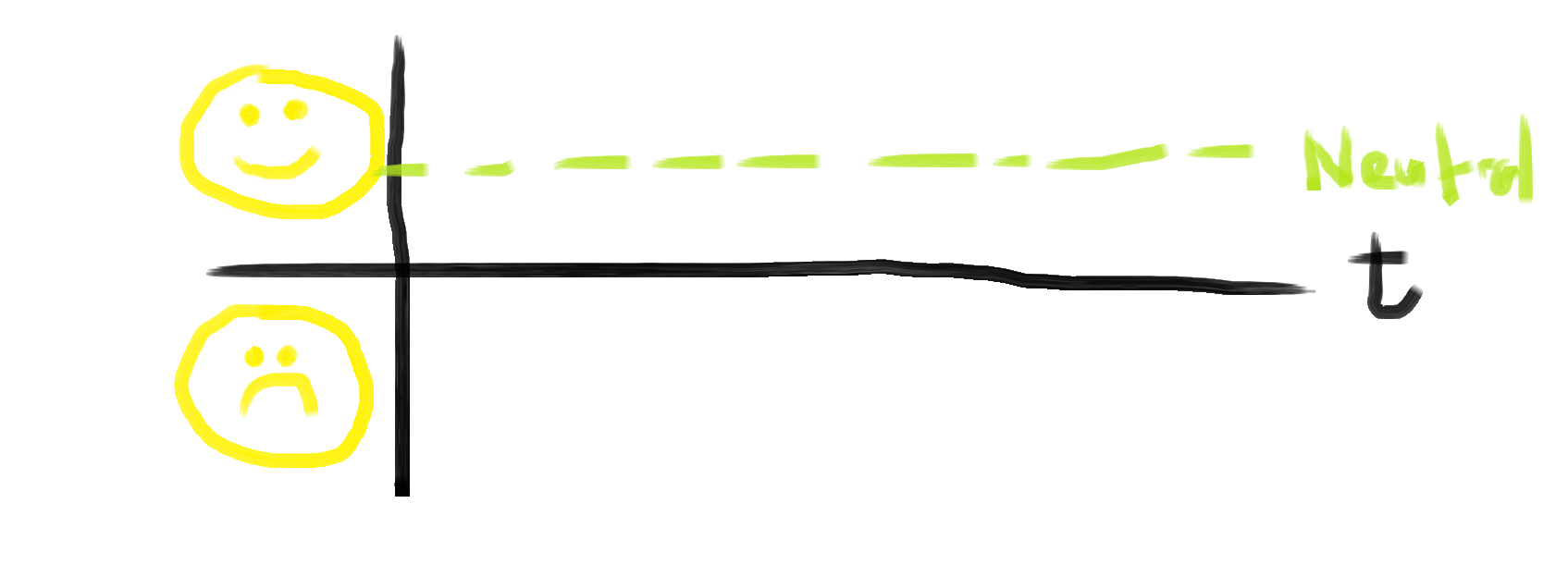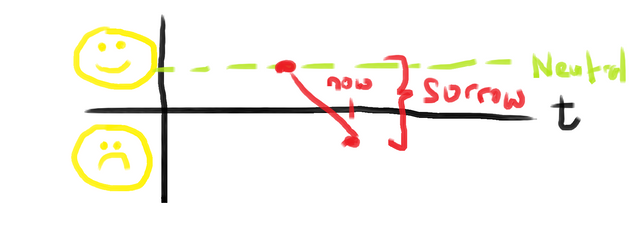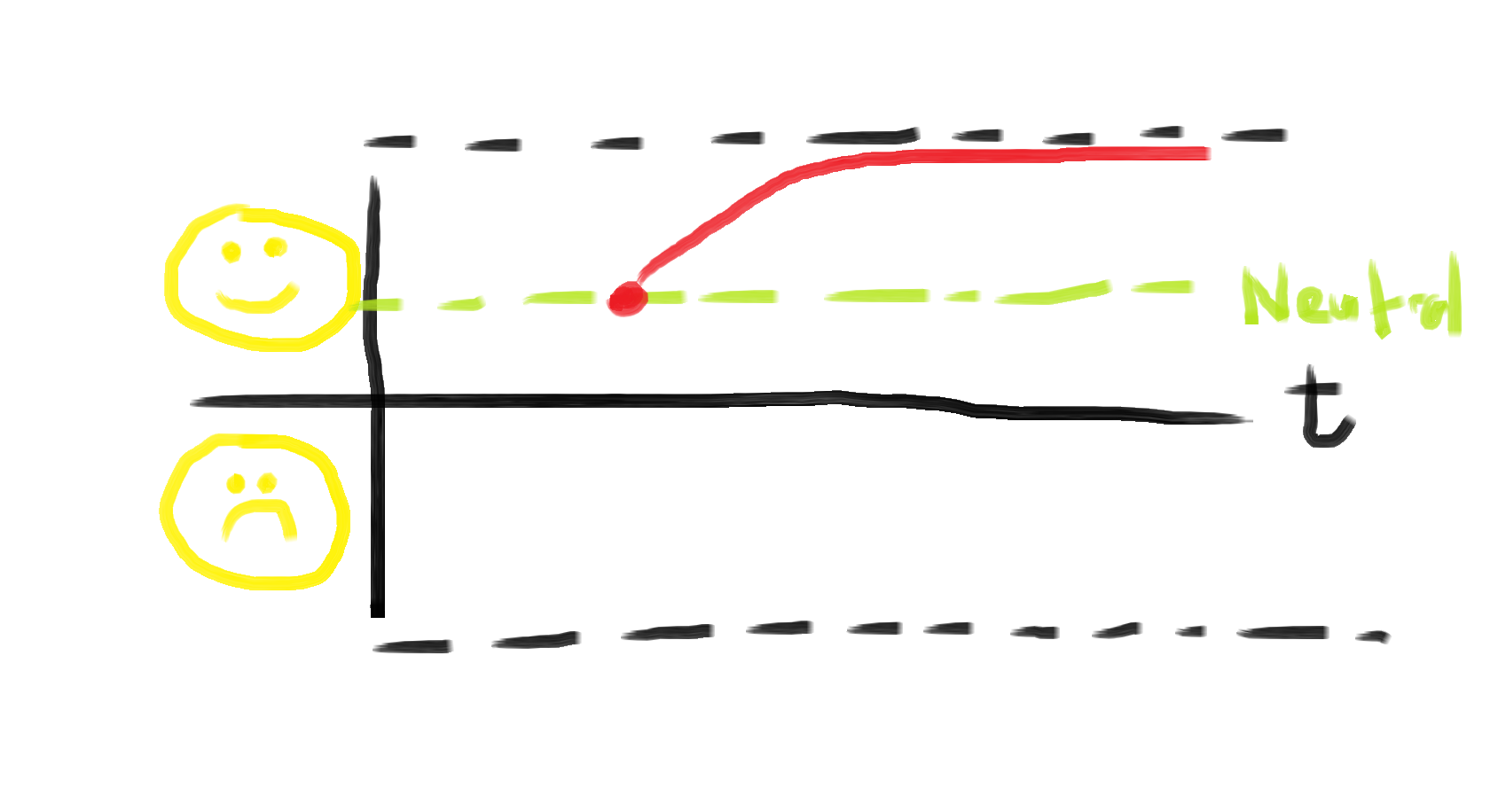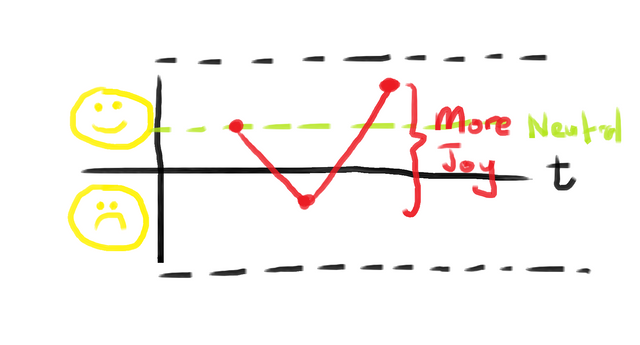Shower Thoughts | Graphical Interpretation of Happiness, Joy and Love - Part 2
If you have not read Part 1 you can do so by clicking here. In Part 1, we talk about the Happiness Chart, the components of the Happiness Chart and the difference between Happiness and Joy.

So now that you know about the basics of the Happiness Chart, we will explore the affects of other emotions on the Happiness Chart.
Emotional Quotient (EQ)
Before we talk about the other emotions, I want to touch a bit about this idea of Emotional Quotient (EQ). It's the buzzword these days in the workplace and in professional settings that everyone talks about, especially when looking for a new job or promotion. But what does it actually mean? What is EQ?
This definition of EQ is not an original idea of mine, but one that was influenced by many sources and heavily inspired from Jon and Missy Butcher in their Lifebook program that I highly recommend anyone to take.
Emotional Quotient = Emotional Intelligence + Emotional Control
Emotional Intelligence is the ability to learn from your emotions. When you're happy or excited, you are able to learn from your happiness, find out what exactly is making you happy, and utilize it in the future to bring about or relive those happy moments. When you're sad, angry or frustrated, you are able to learn from those emotions, identify exactly what made you feel that way, overcome it and learn to avoid/mitigate it in the future to avoid those feelings from manifesting again.
Emotional Control is the ability to control you emotions - duh! Someone with emotional control knows how and when to empathize and sympathize with others. Someone with emotional control knows how to use their emotions and when to use certain emotions to invoke certain energy. Sometimes, it's good to be angry if it gives you the energy needed to get things done. Sometimes, it's good to be sad to show vulnerability to people who need it.
More importantly, someone with emotional control knows how to stop unwanted emotions. A superior or a client may say something that annoys or frustrates you, but someone with emotional control will be able to not let the anger or frustration get to them lest they lose a future promotion or client.
What I want to explore below, is how we can better understand certain emotions on our Happiness Chart - which, if you remember from Part 1, represents our natural state of being and energy level.
NOTE: Please read Part 1 first or the rest of this post may be pretty confusing
Sorrow/Sadness

We've talked a bit about Sorrow/Sadness previously, but I want us to explore it a bit more. I want to clear, what I believe, to be a misconception about emotions. We've always been taught that we should always be happy and that it's not good to be sad or angry or any other "negative" emotions. I believe that emotions do not have bias to them - there is no "good" or "bad" emotion, just emotions. To be emotionally mature, is to understand that every emotion is pure and beautiful and should be embraced to experience the vast beauty and experiences life can provide. However, someone with a high level of EQ would know what to learn from their emotions and then let it go just as easily.
Sadness/Sorrow is important because it gives us more space to achieve joy. There is a limit to our happiness and sadness, as illustrated by the asymptopes (the black dashed lines) in the image below, because it requires a lot of energy to remain happy and it is not sustainable to continuously be happy. It becomes tiring.

However, by embracing sadness/sorrow in our lives, we give ourselves more space for joy as well. This is also reflected in our real life. I don't know about you, but I think that a life where I'm constantly very happy gets boring after awhile. That is why we seek out adventure, we seek out challenge. We, naturally as human beings, try to put ourselves in difficult situations so that when we overcome it, the joy and sweetness of overcoming it just becomes that much more beautiful and enjoyable.

Unfortunately, not every sadness in life is voluntary - where we seek out challenges, there are also plenty of times where sadness happens such as a death in the family, a friend getting into an accident or something that is out of our personal control. But I do believe that we should still adopt a different viewpoint of this sadness. When something like this happens, it pushes us to appreciate our love ones more, it encourages us to spend more time with someone we may have taken for granted. This is where emotional intelligence comes into play.
Sometimes we just don't know when life will U-turn around and we run the risk of falling into an endless spiral down the Happiness Chart. This is where a strong emotional control is necessary. We need to be able to see that, through all this sadness, there is the potential for joy in the future. That there is a silver lining to all this. We need to be able to motivate ourselves and pull ourselves out of this gutter before it's too late.
TL;DR: Embrace sadness, don't avoid it. Sadness just provides you more opportunity for joy if you allow yourself.
--
I thought I'd be able to talk about other emotions in this post, but it's starting to get too long. In my next and maybe final post on this topic, I want to explore another two powerful emotions - Anger and Love - to see how those emotions may affect our graph.
I hope by depicting sadness on the Happiness Chart, you are able to learn a bit more about emotions. Do emotions run exactly like how I described the Happiness Chart - absolutely not. But I find that a lot of exploration and self-awareness into my emotions fit within this graph and if it works and is useful - why not! Just like how Newton's Law of Motion was used to describe the movement of stars before it was replaced by more accurate theories by Einstein does not make Newton's Laws any less valuable to the contribution of science.
I will release Part 3 soon. In the meantime, check out my other posts in my Table of Content or follow me (@chuazm) to look forward to my future posts!
This was a nice read. I don't think I have heard of "Emotional Quotient" prior to now, I only knew of Intelligence Quotient. It is always nice learning new things on Steemit daily.
Old fashioned companies look for people with high IQ. They ask you for your college results, make you do technical exams. That works for companies that work like a machine. I'm sure you've met people who you know are smart, but there's just something you don't like about them or they feel like an asshole and you just don't want to approach them. Those people have low EQ. Companies now are looking for people with high EQ especially with management because, I think, companies realize a happy workplace is a productive workplace.
Glad I could teach you something new!
Yeah, I'm really glad you did. Then having both high IQ and high EQ would definitely make someone more efficient.
I only can follow until the emotional control definition that u gave. When reach happiness chart, I dont get you... Haha :D
What about it don't you get? Did you read Part 1? =p
Ohhh belum... i read now.
Seriously bro...i got lost at the chart...
Which part of the chart don't you understand? The chart was mostly explained in Part 1, Part 2 (this post) doesn't explain the chart because it's explained in Part 1. Or did you read Part 1 and still not understand? Then I'd appreciate some feedback on what made you lost so I can try to explain better
I read ur part 1. I still dont understand the chart. Which part I dont understand? I don't know where to start. I dont understand everything but I think its my problem. The chart looks like 2 heads going for a race...then I am lost.
Oops, I guess I always assumed people would know what an x-y graph is. The vertical line represents happiness, if its positive (top) you are happy, when negative (bottom) you are negative. The horizontal line represents time with past (left), present (current point) and future (right). The overall chart represents the change of your happiness over time.
So you read it from left to right. In the graph below for example, it starts with the first point where you are of a neutral happiness, your usual state. The next point is lower because something bad happened and you became sad. The last point shoots up because something joyful happens and you are back to being more happy. Hopefully, that clarifies things a bit?

I guess that is why i am a photographer and not into mathematics...cheers bro.